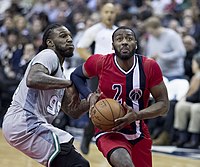Basketball uniform

A basketball uniform is a type of uniform worn by basketball players. Basketball uniforms consist of a jersey that features the number and typically the last name of the player on the back, as well as shorts and athletic shoes. Within teams, players wear uniforms representing the team colors; the home team usually wears a lighter-colored uniform, while the visiting team wears a darker-colored uniform.
Different basketball leagues have different specifications for the type of uniform that is allowed on the court. Early in the history of the sport, basketball was played in any type of athletic attire, but by the 1900s, special uniforms were developed and marketed to basketball players. The style, cut, and fit of basketball uniforms evolved throughout subsequent decades, often modeled after the general fashion trends of the day.
History
[edit]Jerseys and shorts
[edit]
Originally, basketball was played in any type of athletic attire, ranging from track suits to football uniforms. The first official basketball uniforms, as displayed in the Spalding catalog of 1901, featured three types of pants: knee-length padded pants, similar to those worn for playing football, as well as shorter pants and knee-length tights. There were two types of suggested jersey, a quarter-length sleeve and a sleeveless version.[1]
The long pants later evolved into medium-length shorts in the 1920s, and by the 1930s, the material used for jerseys changed from heavy wool to the lighter polyester and nylon. In the 1970s and 80s, uniforms became tighter-fitting and shorts were shorter, consistent with the overall fashion trends of these two decades.[2] At this time, women's basketball uniforms transitioned from longer-sleeved uniforms to tank-top style jerseys similar to men's basketball uniforms, which more explicitly showed off players' muscle tone.[3]

In 1984, Michael Jordan asked for longer shorts and helped popularize the move away from tight, short shorts toward the longer, baggier shorts worn by basketball players today.[4][5] Throughout the 1990s, basketball uniforms fell under the influence of hip hop culture, with shorts becoming longer and looser-fitting, team colors brighter, and designs more flashy and suggestive of rappers' bling.[6]
At the turn of the 21st century, basketball uniforms became even more oversized and loose-fitting; the arm holes in women's basketball jerseys remained smaller than men's, but were wide enough to reveal the players' sports bras.[3]
Sleeved jersey
[edit]
For the Christmas Day games of 2013, the NBA and its apparel partner Adidas introduced a newly designed sleeved jersey with large team and NBA logos on the front.[7] Marketers for the new uniforms realized that fans were unwilling to wear sleeveless jerseys in their day-to-day life and hoped the new sleeved jerseys would be more popular for everyday wear.[8] However, it was also a "not-so-well-kept secret that the NBA wanted to implement jersey ads in the years following the introduction of sleeved jerseys" as the "sleeves allow more space for potential partners to add their corporate logos to jerseys" like association football (soccer). After the league deal with Adidas expired and Nike signed on as the new apparel partner, the sleeved jersey did not continue.[9]
The sleeved jersey was controversial among players. LeBron James famously ripped the sleeves off during a prime time game against the New York Knicks in 2015, but in the 2016 NBA Finals James convinced his teammates to wear the sleeved jerseys in Game 5 and again in the title-clinching Game 7.[9][10][11][12][13][14]
Shoes
[edit]In 1903, a special basketball shoe with suction cups to prevent slippage was added to the official basketball uniform demonstrated in the Spalding catalog.[1] Over the decades, different shoe brands and styles were popular as basketball shoes: Chuck Taylor All-Stars and Keds in the 1960s and 1970s; Adidas and Nike leather high-tops in the late 1970s and 1980s; and Air Jordans in the 1990s.[4]
Now most athletes wear shoes from the brand they are signed with and some even have their own signature shoes. The first person to have their own signature shoe was Walt "Clyde" Frazier when he teamed up with Puma in 1973. Other brands that have made signature shoes for players include, Under Armour (with their most popular being with Stephen Curry), Reebok (with their most popular being with Shaquille O'Neal), New Balance(with their most popular being with Kawhi Leonard), and Anta(with their most popular being Klay Thompson).[15][16]
Accessories
[edit]In the 1970s, Slick Watts and Bill Walton began to wear headbands, which soon became popular with other players. Rick Barry popularized wrist-bands, and other players soon created variations, such as bands that covered their forearms or biceps. These were used to wipe off sweat, or simply worn as fashion statements.[4] In 2001, Allen Iverson popularized the arm sleeve, originally used to help his bursitis in his right elbow.[17]
Women's
[edit]In the 19th-century what women wore was controlled by men. When they played women wore floor-length wool skirts. In the '20s they introduced a shorter version of the wool-skirts. In the '30s the movement towards baggy button-able shorts. The '40s and '50s were a huge turning point for women's uniform.
As production became cheaper the wool uniforms were replaced by more functional polyester and nylon's. During this time belted satin shorts were also progressively being used.
Going into the '60s the skirts were starting to disappear and shorts with elastic waistbands were introduced. Finally from 1980 till now women's uniform are now similar to men's. As they began to wear loose longline shorts, and skirts were eliminated entirely.[18]
Modern day
[edit]United States basketball
[edit]Rules and regulations
[edit]In professional basketball leagues today, teams playing at home typically wear lighter-colored uniforms than the visiting team.[19]
The NBA eliminated "home" and "away" uniform designations prior to the 2017–18 season. Teams' white uniforms were then designated as "Association" uniforms, and their color uniforms were designated as "Icon" uniforms. Teams also unveiled two alternative uniforms, designated as "Statement" and "City" uniforms. Furthermore, the home team is now allowed to wear any uniform color it chooses, while its opponent may wear any color that sufficiently contrasts with the home team's choice.[20]
NBA basketball shorts must fall at least 1 inch above the knee, and T-shirts cannot be worn under the jersey – however, they are permitted in American college basketball. Some NBA and WNBA teams have allowed sponsors' logos to appear on their uniforms.[21]
Material
[edit]Uniforms are made of wicking material designed to absorb sweat and ensure that it evaporates faster.[2] They are the product of a four-year study researching professional basketball players, who identified the need for fewer seams, lighter weight, and faster drying and cooling in their jerseys.[5]
International basketball leagues
[edit]The main difference between U.S. basketball uniforms and those of other countries is the appearance of sponsorship iconography; European basketball uniforms are often covered in the logos of their sponsors (similar to association football), while the U.S. uniforms (like other major U.S. pro sports) feature the team wordmark/logo front and center.[22]
For the 2017–18 season, some U.S. teams have started putting sponsorship logos on their jerseys on the upper left of the jersey which is a maximum of 2.5 inches by 2.5 inches.[23]
Women's
[edit]
Women's uniforms today are similar to the men's uniform. It is common now to see Lycra compression shorts, sweat-wicking polyester vests, lightweight jerseys and breathable baggy shorts.
In the WNBA the women are allowed to chose which styles and fabrics best suits them.[18]
See also
[edit]References
[edit]- ^ a b James Naismith (1941). Basketball: Its Origin and Development. U of Nebraska Press. pp. 89–90. ISBN 0-8032-8370-9.
- ^ a b Lucia Raatma (1 January 2012). The Curious, Captivating, Unusual History of Sports. Capstone Press. p. 13. ISBN 978-1-4296-7537-6.
- ^ a b Sarah McCullough (2007). Construction of the Female Athletic Body: A Study of Women's Sport Uniforms. pp. 76–78. ISBN 978-0-549-26375-3.
- ^ a b c Nate LeBoutillier (1 January 2011). The Best of Everything Basketball Book. Capstone. pp. 58-59. ISBN 978-1-4296-5468-5.
- ^ a b Suzanne Slade (1 January 2013). The Technology of Basketball. Capstone. pp. 20–21. ISBN 978-1-4296-9956-3.
- ^ Jeffrey Lane (1 December 2007). Under the Boards: The Cultural Revolution in Basketball. U of Nebraska Press. p. 41. ISBN 978-0-8032-0755-4.
- ^ Patt, Jason (25 December 2013). "NBA Christmas Day uniforms 2013: Teams to wear new sleeved jerseys". SBNation. Retrieved 25 December 2013.
- ^ Holmes, Elizabeth (13 November 2013). "NBA Christmas Jerseys—Now With Sleeves". The Wall Street Journal. Retrieved 25 December 2013.
- ^ a b "The rise and fall of the NBA's sleeved jerseys". 6 October 2017.
- ^ "Cavs Unveil Three New Alternate Uniforms for 2015-16 Season". NBA.com/Cavaliers. NBA Media Ventures, LLC. October 21, 2015. Retrieved October 22, 2015.
- ^ "Cavs wearing sleeved jerseys in Game 7". SI.com. 19 June 2016. Retrieved 2017-06-17.
- ^ Vardon, Joe (4 June 2017). "Cavaliers wearing black jerseys for Game 2: 2017 NBA Finals". cleveland.com. Retrieved 2017-06-17.
- ^ "Cavaliers Logo Suite Evolves to Modernize Look". NBA.com/Cavaliers. NBA Media Ventures, LLC. May 31, 2017. Retrieved June 13, 2017.
- ^ Boone, Kyle (1 June 2017). "LOOK: Cavs unveil new logos, add black to color scheme before start of NBA Finals". CBSSports.com. Retrieved 2017-06-17.
- ^ Bowers, Brendan. "From Chuck Taylor to LeBron X: Year-by-Year Evolution of NBA Sneakers". Bleacher Report. Retrieved 2023-05-06.
- ^ Dodson, Aaron (2019-02-05). "The forgotten history of Puma basketball". Andscape. Retrieved 2023-05-06.
- ^ Tillery, Michael. "The Allen Iverson Sleeve: How the Philadelphia 76ers star influenced fashion and culture in American sports". www.sportskeeda.com. Retrieved 2023-04-26.
- ^ a b Evans, Georgina. "SKIRTS AND THE SLAM DUNK: THE HISTORY OF WOMEN'S BASKETBALL UNIFORMS". Retrieved May 9, 2023.
- ^ P. J. Harari; Dave Ominsky (1 October 2002). Basketball Made Simple: A Spectator's Guide. First Base Sports, Inc. p. 10. ISBN 978-1-884309-13-7.
- ^ Whitaker, Lang (July 18, 2017). "NBA, Nike unveil new uniforms for 2017-18 season". NBA.com. Retrieved October 15, 2018.
- ^ Sandomir, Richard (31 May 2009). "In W.N.B.A., Jersey Sponsorship Could Set New Standard". The New York Times. Retrieved 25 December 2013.
- ^ O'Brien, Dan. "NBA Debate: Should the NBA Put Advertisements on Jerseys?". The Bleacher Report. Retrieved 25 December 2013.
- ^ "An ongoing list of every NBA sponsor patch for 2017-18 season". 26 July 2017.





